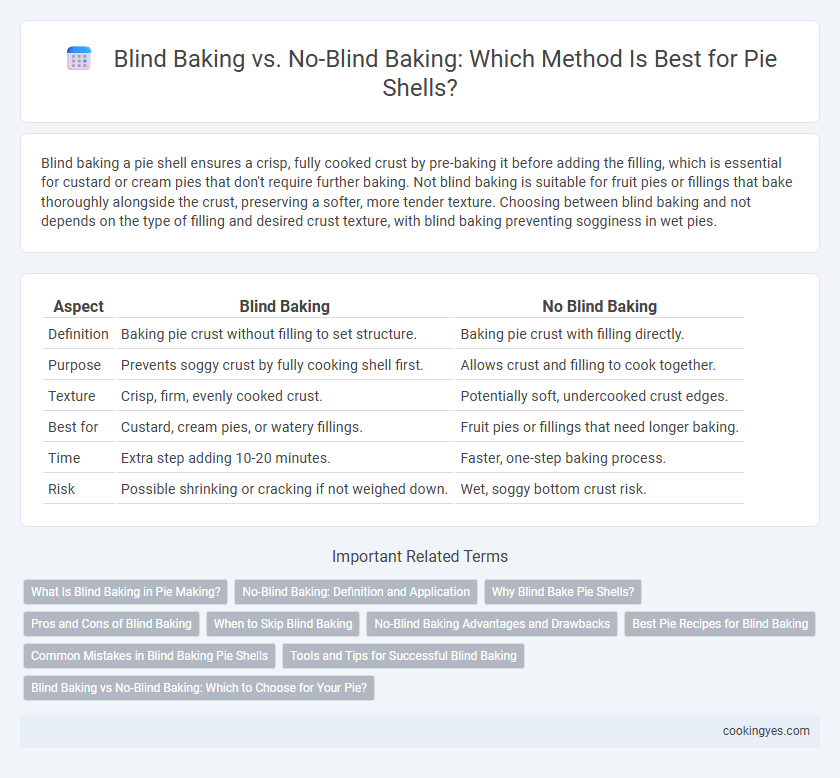Blind baking a pie shell ensures a crisp, fully cooked crust by pre-baking it before adding the filling, which is essential for custard or cream pies that don't require further baking. Not blind baking is suitable for fruit pies or fillings that bake thoroughly alongside the crust, preserving a softer, more tender texture. Choosing between blind baking and not depends on the type of filling and desired crust texture, with blind baking preventing sogginess in wet pies.
Table of Comparison
| Aspect | Blind Baking | No Blind Baking |
|---|---|---|
| Definition | Baking pie crust without filling to set structure. | Baking pie crust with filling directly. |
| Purpose | Prevents soggy crust by fully cooking shell first. | Allows crust and filling to cook together. |
| Texture | Crisp, firm, evenly cooked crust. | Potentially soft, undercooked crust edges. |
| Best for | Custard, cream pies, or watery fillings. | Fruit pies or fillings that need longer baking. |
| Time | Extra step adding 10-20 minutes. | Faster, one-step baking process. |
| Risk | Possible shrinking or cracking if not weighed down. | Wet, soggy bottom crust risk. |
What Is Blind Baking in Pie Making?
Blind baking in pie making refers to pre-baking the pie crust before adding the filling, ensuring a crisp and fully cooked shell. This technique prevents sogginess, especially important for custard or cream pies where the filling is added raw. Blind baking involves lining the crust with parchment paper and filling it with pie weights or dried beans to maintain shape during baking.
No-Blind Baking: Definition and Application
No-blind baking refers to the process of baking pie shells without pre-baking or partially baking the crust before adding the filling. This technique is ideal for pies with fillings that require simultaneous baking, such as custards or fruit pies, where the moisture from the filling helps cook the crust. No-blind baking simplifies preparation but may result in a softer, less crisp crust compared to blind baking.
Why Blind Bake Pie Shells?
Blind baking pie shells ensures a crisp, fully cooked crust by preventing sogginess from wet fillings. It creates a sturdy barrier that stops moisture from soaking into the dough, preserving optimal texture. This technique is especially crucial for custard, cream, or fruit pies with high-moisture ingredients.
Pros and Cons of Blind Baking
Blind baking pie shells prevents sogginess by pre-cooking the crust, ensuring a crisp and stable base for wet fillings like custards or fruit pies. However, this process can cause shrinkage or over-browning if not carefully monitored, requiring pie weights and precise timing. Skipping blind baking saves time but risks a soggy bottom and uneven texture, especially for delicate or moist fillings.
When to Skip Blind Baking
Skipping blind baking is ideal for pies with fillings that bake fully in the shell, such as fruit pies, where moisture is absorbed during baking, preventing a soggy crust. It is advisable to avoid blind baking for custard or cream pies, where the filling is cooked separately and the pie shell can be baked partially or fully beforehand. Avoid blind baking if the recipe instructs a single bake time for both crust and filling to ensure optimal texture and flavor integration.
No-Blind Baking Advantages and Drawbacks
No-blind baking pie shells eliminates the extra step and time required for pre-baking, allowing the crust to develop a more integrated texture with the filling and retain moisture, which is ideal for wet or custard pies. However, this method can result in a soggy or undercooked bottom crust, as the filling's moisture often prevents full crispiness. Bakers must balance the risk of a limp crust against the time savings and enriched flavor that no-blind baking offers.
Best Pie Recipes for Blind Baking
Blind baking pie shells ensures a crisp, golden crust ideal for custard or cream pies that require filling without baking. Best pie recipes for blind baking include key lime pie, chocolate cream pie, and lemon meringue pie, where a fully cooked crust prevents sogginess. Using pie weights or dried beans during blind baking maintains the shell's shape and promotes even cooking for perfect texture.
Common Mistakes in Blind Baking Pie Shells
Common mistakes in blind baking pie shells include failing to prick the dough, which allows steam to create bubbles and uneven surfaces. Using insufficient pie weights or none at all often causes the crust to shrink or puff up, resulting in an uneven bake. Overbaking or underbaking the shell can lead to a dry crust or a soggy bottom when filling is added later.
Tools and Tips for Successful Blind Baking
Using pie weights or dried beans in a pie shell during blind baking prevents bubbling and shrinking, ensuring a crisp, evenly cooked crust. A heavy-duty pie dish and a fork for docking the dough around the edges are essential tools to maintain shape and prevent puffing. Lining the shell with parchment paper before adding weights improves heat distribution and makes removal easier, resulting in a perfected pie base.
Blind Baking vs No-Blind Baking: Which to Choose for Your Pie?
Blind baking a pie shell involves pre-baking the crust before adding the filling, ensuring a crisp, fully cooked pastry ideal for custard or cream pies. No-blind baking means filling the shell before baking, which works well with fruit pies where the filling's moisture helps cook the crust. Choosing between blind baking and no-blind baking depends on the filling type and desired crust texture for a perfect pie.
Blind baking vs no-blind baking for pie shells Infographic

 cookingyes.com
cookingyes.com